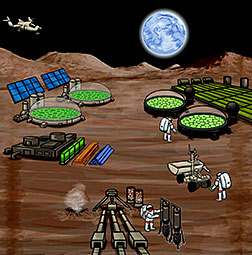- Number 427 |
- November 24, 2014
Synthetic biology for space exploration

Microbial-based biomanufacturing could be
transformative once explorers arrive at an
extraterrestrial site.
(Image courtesy of Royal Academy Interface)
Does synthetic biology hold the key to manned exploration of Mars and the Moon? Researchers with the Department of Energy’s Lawrence Berkeley National Laboratory (Berkeley Lab) carried out a techno-economic analysis demonstrating “the significant utility” of deploying non-traditional biological techniques for manned long-duration space missions.
“Not only does synthetic biology promise to make the travel to extraterrestrial locations more practical and bearable, it could also be transformative once explorers arrive at their destination,” says Adam Arkin, director of the Physical Biosciences Division at DOE's Berkeley Lab and a leading authority on synthetic and systems biology.
“During flight, the ability to augment fuel and other energy needs, to provide small amounts of needed materials, plus renewable, nutritional and taste-engineered food, and drugs-on-demand can save costs and increase astronaut health and welfare,” Arkin says. “At an extraterrestrial base, synthetic biology could even make more effective use of the catalytic activities of diverse organisms.”
One of the biggest challenges to manned space missions is the expense. The NASA rule-of-thumb is that every unit mass of payload launched requires the support of an additional 99 units of mass, with “support” encompassing everything from fuel to oxygen to food and medicine for the astronauts, etc. Most of the current technologies now deployed or under development for providing this support are abiotic, meaning non-biological.
To date, Berkeley Lab researchers have used synthetic biology to produce an inexpensive and reliable microbial-based alternative to the world’s most effective anti-malaria drug, and to develop clean, green and sustainable alternatives to gasoline, diesel and jet fuels. In the future, their techno-economic analysis suggests that synthetic biology could also be used to make manned space missions more practical.
“Because synthetic biology allows us to engineer biological processes to our advantage, we found in our analysis that technologies, when using common space metrics such as mass, power and volume, have the potential to provide substantial cost savings, especially in mass,” says Amor Menezes, a postdoctoral scholar in Arkin’s research group and collaborator in this study.
In their study, the authors looked at four target areas: fuel generation, food production, biopolymer synthesis, and pharmaceutical manufacture. They showed that for a 916 day manned mission to Mars, the use of microbial biomanufacturing capabilities could reduce the mass of fuel manufacturing by 56-percent, the mass of food-shipments by 38-percent, and the shipped mass to 3D-print a habitat for six by a whopping 85-percent. In addition, microbes could also completely replenish expired or irradiated stocks of pharmaceuticals, which would provide independence from unmanned re-supply spacecraft that take up to 210 days to arrive.
The big advantage biological manufacturing holds over abiotic manufacturing is the remarkable ability of natural and engineered microbes to transform very simple starting substrates, such as carbon dioxide, water biomass or minerals, into materials that astronauts on long-term missions will need. This capability should prove especially useful for future extraterrestrial settlements.
“Microbes could be used to greatly augment the materials available at a landing site,” Arkin says. “They could enable the biomanufacturing of food and pharmaceuticals, and possibly even modify and enrich local soils for agriculture in controlled environments.”[Lynn Yarris, 510.486.5375,
lcyarris@lbl.gov]
